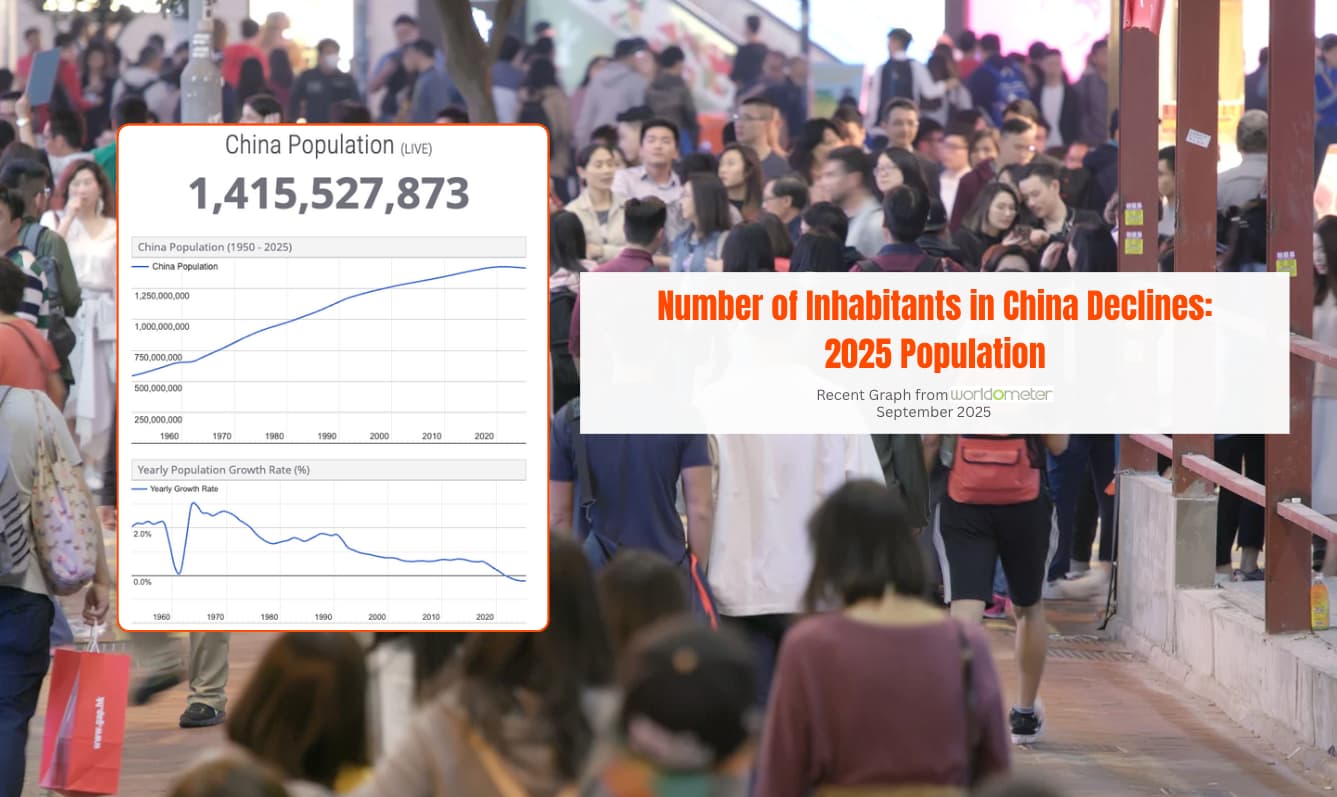When you think about the world’s most populated countries, China always comes to mind. As of mid-2025, the number of inhabitants in China is about 1.416 billion, but that figure has been falling for three years in a row. This shift marks a historic turning point for a country long known for its massive population growth.
You will see how this decline affects everything from the size of the workforce to the pace of economic growth. The changes are not just about numbers; they reveal why families are having fewer children, how cities are transforming, and what challenges lie ahead for social systems.
This guide provides a clear overview of the current population, the reasons behind the decline, and the broader implications that follow.
By the end, you will understand how China’s demographic changes shape its future and why the rest of the world is watching closely.
Quick Insights ⚡:
- 2025 mid‑year estimate: ~1.416 billion inhabitants, down 0.23% (~3.2 million) from 2024. (Stats from Worldometer).
- 2024 population: ~1.408 billion, marking the third consecutive year of decline
- Birth‑death gap: More deaths than births continue to drive shrinkage.
- Long-term projections: The population could fall to ~1.3 billion by 2050, with a potential drop to 639 million by 2100.
- Impacts: Mounting economic strain—aging, labor shortages, pensions under pressure.
Current Number of Inhabitants in China
You can better understand the population of China by looking at the most recent official totals, comparing those numbers to earlier years, and reviewing estimates from different studies and reports. This helps you see both the current situation and how it has changed over time.

Source: @https://www.worldometers.info/world-population/china-population/
Official Population Figures for 2025
In 2025, the official population of China is about 1.41 billion people. This figure comes from government statistics that track births, deaths, and migration each year.
The number shows that China remains the most populous country in the world, though India has recently begun to surpass it in some estimates. Population growth in China has slowed down because of lower birth rates and an aging society.
Key points you should note:
- Birth rate: Fewer children are being born each year.
- Aging population: The share of people over 60 continues to rise.
- Urbanization: More than 60% of people now live in cities.
These official numbers are important because they guide economic policies, labor planning, and social services.
Comparison With Previous Years
If you look back, China’s population grew quickly in the second half of the 20th century. By the 2010 census, the country had 1.34 billion people, according to China’s 2010 census data.
By 2020, the count rose to about 1.41 billion. Growth has slowed since then, and in some years the population has even started to decline slightly.
Here is a simple table comparing the numbers:

Source: @https://www.worldometers.info/world-population/china-population/
You can see that the increase from 2010 to 2020 was much larger than from 2020 to 2025. This shows how much the growth rate has slowed.
Population Estimates by Source
Different studies and reports give slightly different totals for the population of China. For example, one analysis of demographic data points out that China’s population may peak soon and then begin to shrink.
Some estimates suggest that the peak may already have passed, while others expect it to happen within the next decade. These differences come from how each source counts births, deaths, and migration.
You might see:
- Government figures: Around 1.41 billion in 2025.
- Independent studies: Often similar, but some predict a small decline already.
- Long-term projections: Many expect a steady drop after the 2030s.
By comparing these sources, you can get a clearer picture of both the current size of the population and the challenges China faces in the future.
📌Also Read: 8 Forbidden Zones in China: Restricted Areas for Foreigners
Population Decline: When and How Much?
You can see that China’s population has entered a period of steady decline after decades of growth. The first clear drop occurred recently and has continued into subsequent years.
In 2022, the population fell by about 850,000 people, which was the first decrease since the famine years of 1961. This marked a turning point in the country’s demographic history.
The decline did not stop there.
- 2023: about 2.08 million fewer people were recorded.
- 2024: another 1.39 million decline, leaving the total population at around 1.408 billion.
Several factors explain this shift. Fertility rates remain well below replacement level, and the number of births is no longer enough to balance the aging population. Research has shown that population policies in China played a large role in lowering birth rates over past decades.
Urban areas also show patterns of shrinking density. A study of major cities proposed an exponential model of urban population decline, highlighting how numbers drop over time as fewer young families settle in.
These changes mean you are now looking at a country where the number of inhabitants is falling year by year, something not seen in modern China until very recently.
📌Also Read: What Does Passport Book Number Mean in China
Why is China’s Population Shrinking?
China’s population is shrinking due to a decline in births, low fertility rates, and rapid population aging. These shifts affect how many people are working, how families are structured, and how resources are shared.
Demographic Imbalance
You have seen a major shift in China’s population trends. In 2022, the country recorded more deaths than births for the first time in six decades.
This pattern continued through 2023 and 2024, showing that the population of China is now in long-term decline.
The imbalance comes from two sides. Fewer children are being born each year, while the number of elderly people dying is increasing.
This creates a natural population drop that cannot be easily reversed through short-term policies.
Researchers have identified shrinking cities in China where population loss is most visible, especially in the northeast and central regions.
These areas face both declining birth rates and high out-migration, which makes the imbalance worse.
Low Fertility Levels
You are also seeing extremely low fertility levels. In 2024, China’s fertility rate was about 1.15 children per woman, far below the replacement level of 2.1. This means each generation is smaller than the one before it.
Several factors explain this. Families face high housing and education costs, and many young couples delay or avoid having children. Women often prioritize careers, and support for childcare remains limited.
Government policies that once restricted births now encourage larger families, but the shift has not changed behavior. Even with incentives, surveys show many people do not want more than one child. As a result, the population of China continues to shrink.
Aging Society
You will also notice that China is aging faster than most countries. By 2050, nearly 39 percent of the population may be over retirement age. This means a much higher dependency ratio, with fewer workers supporting more retirees.
Key issues include:
- Pension strain is a concern as funds risk running out by the 2030s.
- Healthcare demand is rising sharply among older adults.
- Labor shortages are expected as the working-age population shrinks.
Studies warn that China’s population will continue to shrink as this aging trend accelerates. With fewer young people and more elderly citizens, economic growth and social support systems face serious pressure.
📌Also Read: What Is Illegal in China? Stay Safe and Informed
Wider Implications of Population Decline
China’s falling birth rates and aging society affect the economy, social systems, and the way work is organized. These changes create pressure on pensions, healthcare, and the labor force while also pushing the government and industries to adjust policies and adopt new technologies.
Economic and Social Challenges
You face a future where fewer young workers enter the labor market while the number of retirees grows. This shift reduces the supply of labor and raises the cost of supporting an older population.
The pension system already struggles with funding, and a shrinking workforce makes it harder to sustain. Healthcare spending also rises as more people live longer with chronic conditions.
Rural areas may feel the impact more strongly. Young people often move to cities, leaving behind older residents and weakening local economies. This uneven pattern creates gaps between urban and rural living standards.
If population decline continues, economic growth could slow. With fewer workers, industries may struggle to expand, and consumer demand may flatten. These trends are already visible in reports on China’s demographic history and future challenges.
Policy Responses
You see the government testing different approaches to slow population decline. The one-child policy ended years ago, followed by the two-child and now the three-child policy. These changes aim to encourage larger families, but high living costs and work pressures limit results.
Another step is delaying the retirement age. This keeps older workers in the labor force longer and eases pressure on the pension system. It also helps balance the ratio of workers to retirees.
Fertility support is another focus. Policies include childcare subsidies, tax breaks, and housing incentives. Some cities also expand parental leave to make family life more manageable.
These measures show that leaders recognize the risks. Still, as studies on China’s population trends and fertility policy note, social attitudes and economic realities often limit the effect of policy changes.
Automation and Technological Shifts
You will notice industries turning to machines and software to fill labor gaps. Robotics and artificial intelligence already play a role in factories, logistics, and even healthcare. This helps reduce reliance on a shrinking workforce.
Automation also supports productivity growth. For example, automated warehouses and delivery systems allow companies to operate with fewer workers. This keeps costs stable even when labor is scarce.
However, not all needs can be met by machines. Emotional care, social interaction, and personal services require human workers. Elderly care is one clear example where robots cannot replace human contact.
As the effects of aging and urbanisation on China’s population show, demand for both technology and human-centered services will grow together. You will see more balance between automation and policies that support people in caregiving roles.
📌Also Read: What Food Do We Import from China? Full List
Conclusion
China’s population, which was around 1.416 billion in 2025, continues to decline following a historic demographic turning point in 2022.
With a shrinking and aging populace, the nation faces compounding economic and social challenges.
Projections through 2050 and beyond underscore the urgency for sustained policy innovation, economic adaptation, and social resilience.
FAQs About the Number of Inhabitants in China
You can learn about the size of China’s population, how it compares to India, and whether it is growing or shrinking. You will also see population projections, growth rates, and density figures that reflect current demographic trends.
What is the current population of China as of 2025?
As of 2025, China’s population is estimated at 1.41 billion people. This makes it one of the most populous countries in the world, though it has recently seen slower growth.
How does China's population compare to India's?
India has now surpassed China in total population. India’s population is estimated at 1.43 billion in 2025, while China’s stands slightly lower at around 1.41 billion.
What are the projections for China's population by 2050?
By 2050, China’s population is expected to decline to around 1.3 billion or lower, depending on fertility and aging trends. Demographers point to a shrinking workforce and a rapidly aging society as key factors.
What is the annual growth rate of China's population?
China’s annual growth rate is close to zero in 2025. In fact, many estimates suggest the country may already be experiencing a slight decline in population numbers each year.
Is China's population increasing or decreasing?
China’s population has started to decrease after decades of steady growth. Low birth rates, longer life expectancy, and the effects of past family planning policies all contribute to this decline.
What is the population density of China in recent years?
China’s population density averages about 150 people per square kilometer. Density is much higher in urban areas, while large parts of western China remain sparsely populated. Data from past surveys of urban households highlight how residential occupancy varies widely between regions.
Subscribe to receive updates
Subscribe to receive the latest blog posts to your inbox every week.






